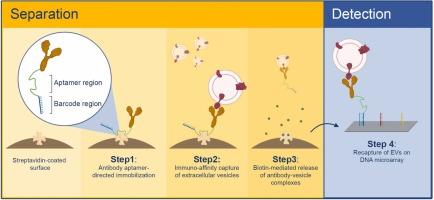利用抗体-aptamer共轭物依次分离和分析细胞外囊泡
IF 8
1区 化学
Q1 CHEMISTRY, ANALYTICAL
引用次数: 0
摘要
细胞外囊泡(EVs)是细胞分泌的膜结合囊泡,其成分多种多样,反映了其细胞来源。EV具有作为液体活检生物标记物的巨大潜力,EV研究催生了各种分离技术。然而,最佳策略仍未达成共识。根据表面标记选择性捕获 EV 的免疫沉淀法前景广阔,但成本高、产量低,而且在释放过程中可能造成损伤。在这项研究中,我们提出了一种创新的抗体-适配体共轭物(AAC):一种用于分离 EVs 的三组分分离试剂。我们详细介绍了 AAC 的开发和验证过程,证明了它在从复杂样本中分离完整 EV 方面的功效。独特的条形码 DNA 序列可在 DNA 微阵列芯片上进行高通量分析,解决了现有方法的局限性。这种方法为选择性 EV 分离和分析提供了一种有效且具有成本效益的替代方法,对液体活检应用中的诊断和治疗进步具有重要意义。本文章由计算机程序翻译,如有差异,请以英文原文为准。

Sequential separation and profiling of extracellular vesicles using antibody-aptamer conjugates
Extracellular vesicles (EVs) are membrane-bound vesicles secreted by cells, exhibiting diverse compositions reflective of their cellular origin. With significant potential as biomarkers for liquid biopsies, EV research has led to various isolation techniques. However, a consensus on the optimal strategy remains elusive. Immunoprecipitation, selectively capturing EVs based on surface markers, is promising but hindered by cost, low yields, and potential damage during release. In this study, we propose an innovative Antibody-Aptamer Conjugate (AAC): a three-component separation reagent for the separation of EVs. Combining an EV-specific antibody, a streptavidin-binding aptamer, and a unique barcode DNA sequence, this conjugate serves dual roles, facilitating both EV separation and subsequent multiplexed analysis. We detail the development and validation of the AAC, demonstrating its efficacy in isolating intact EVs from complex samples. The unique barcode DNA sequence enables high-throughput analysis on a DNA microarray chip, addressing limitations of existing methodologies. This approach offers a valid and cost-effective alternative for selective EV isolation and analysis, with implications for diagnostic and therapeutic advancements in liquid biopsy applications.
求助全文
通过发布文献求助,成功后即可免费获取论文全文。
去求助
来源期刊

Sensors and Actuators B: Chemical
工程技术-电化学
CiteScore
14.60
自引率
11.90%
发文量
1776
审稿时长
3.2 months
期刊介绍:
Sensors & Actuators, B: Chemical is an international journal focused on the research and development of chemical transducers. It covers chemical sensors and biosensors, chemical actuators, and analytical microsystems. The journal is interdisciplinary, aiming to publish original works showcasing substantial advancements beyond the current state of the art in these fields, with practical applicability to solving meaningful analytical problems. Review articles are accepted by invitation from an Editor of the journal.
 求助内容:
求助内容: 应助结果提醒方式:
应助结果提醒方式:


